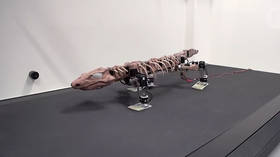Scientists 'resurrect' giant prehistoric lizard as a walking robot (VIDEO)

European researchers have animated a prehistoric four-legged creature that lived before the dinosaurs by studying its gait and making a robotic model that can walk the earth just like its prototype 280 million years ago.
The model is the result of thorough research by a multidiscipline team led by John Nyakatura of Humboldt University, Berlin, which published a paper on reverse-engineering of the stem amniote Orobates pabsti in the Nature journal.
The task was made possible by the extinct species' completely preserved skeleton and fossils of its tracks. The scientists scanned the skeleton in three dimensions and came up with a 3D digital model that could be animated.
However, it was not enough to determine how the creature walked, as it depends on a range of factors such as the amount of cartilage, the angle at which it can bend its spine, and other parameters. The scientists attempted to determine a range of motion for each joint and "forced" the digital model to walk inside the footsteps.
In order to be more precise in their simulation, the researchers filmed the gait of modern species like the iguana and the caiman, establishing four key parameters: power, balance, precision, and ground reactive force.
While these manipulations have considerably narrowed down the possibilities of how the amniote moved in the environment, the computer model did not account for gravitation and other physical constraints.
So the researchers took their project a step further, creating a dynamic simulation model called OroBot.
Watching OroBot in action allowed them to validate their predictions, which defy some earlier hypotheses. For instance, researchers now believe that the prehistoric lizard "exhibited more advanced locomotion than has previously been assumed for earlier tetrapods" or in other words, was able to walk away from the water farther than previously believed.
While the model is as accurate as possible given the limited data available, the exact parameters, like the amount of cartilage or power efficiency with which the prehistoric lizard moved, are unknown.
That's why the paleontologists set up a website where one can toy with parameters and make the lizard crawl or walk upright.
"You can allow bones to collide freely or just gently touch. Or you can dial it up to a level of 4 and allow no collisions, which is basically saying there must be a substantial space between the joints," coauthor on the new paper, biomechanist John Hutchinson at the Royal Veterinary College, told Wired.
The research may give scientists insight into how fast early land-going species adjusted to the environment and pave the way for similarly "resurrecting" other long-extinct animals.
Think your friends would be interested? Share this story!
















